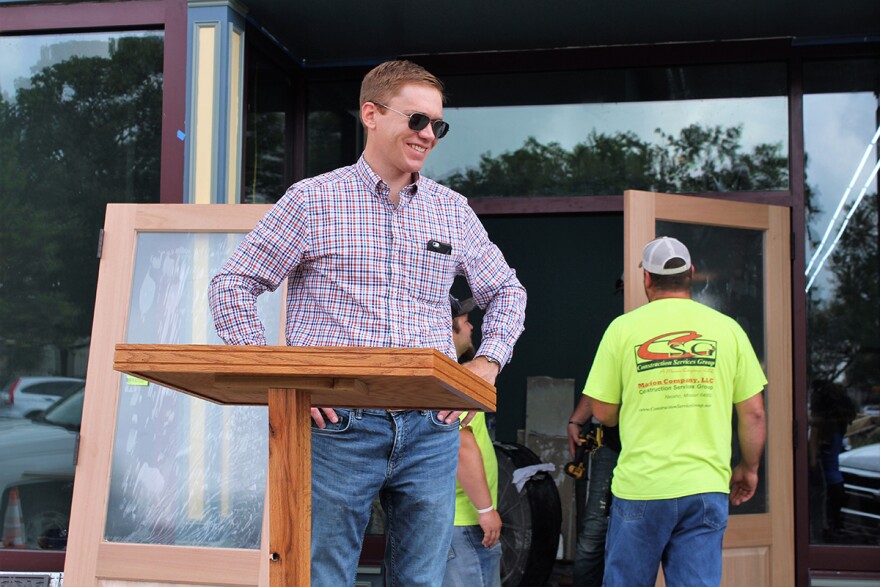Editor’s note: This story was updated at 6:30 p.m. Sept. 19.
Residents of Allen County in Kansas are getting some national recognition for their health-improvement efforts.
The county is one of eight 2017 winners of the Culture of Health Prize awarded by the Robert Wood Johnson Foundation, the nation’s largest public health philanthropy.
Richard Besser, the foundation’s president and CEO, traveled to Iola, the county seat, to make the announcement in person Tuesday.
“When we talked as a team at the foundation as to where I should be for the announcement, it struck us that there was no better place to be than right here in Allen County because what you’re doing here is a model for the nation,” Besser said during a ceremony on the town square.
Since its inception in 2013, the prize has gone to 35 communities across the country “that are thinking big” and engaging citizens to address barriers to improved health, Besser said.
Battling decades of decline
There were plenty of problems to tackle in Allen County.
Over the past century, people and jobs disappeared. After a while, so did hope that things could get any better.
In 2010, something called the County Health Rankings came along to substantiate the decline and in the eyes of some add insult to injury. The rankings, which charted the health of counties in all 50 states, ranked Allen County near the bottom of Kansas’ 105 counties.
The rankings confirmed that decades of economic loss had taken a toll on people’s health. High rates of smoking, obesity and diabetes were cutting short the lives of too many of the county’s residents.
About the same time, Thrive Allen County, a nonprofit organization formed by the Johnson County-based REACH Healthcare Foundation, was preparing to launch an effort to turn things around under the guidance of new CEO David Toland.

Toland was an Allen County native who had recently returned after working in the Washington, D.C., Office of Planning, where he led an effort to overhaul the district’s comprehensive plan. When he arrived in Allen County, Toland said he was struck by the similarities between D.C. and his rural Kansas home.
“Both were places that had seen decades of disinvestment, population loss and poor health outcomes,” Toland said.
But after years of work, Toland said he’s recognizing indications of a turnaround in Allen County similar to what occurred in the nation’s capital.
“I’m seeing the same kind of early indicators,” he said. “So, I have a lot of hope. But I also know we have a long way to go.”
Signs of progress
There are visible signs of progress in communities across Allen County, but nowhere is that progress more evident than in Iola. In 2010, county voters approved an increase in the sales tax to finance a new critical access hospital, which is now open.

A new apartment complex now stands on the site of the old 1950s-era hospital and a new grocery store is going up next door. Both are the result of public-private partnerships, Toland said.
Parts of town ravaged by flooding in 2007 were reclaimed and transformed into athletic fields and a community garden. Walking and biking trails crisscross the town and link it to the neighboring community of Humboldt, 11 miles away.
Besser and others on hand for the announcement were taken on a whirlwind tour of the sites, riding on an old school bus that has been repurposed to deliver summer meals to children who have little to eat once the school year ends.
There is also progress on the health front. While Allen County’s No. 92 rank in the 2017 County Health Rankings still puts it in the bottom tier of Kansas counties, residents are working to address some of the underlying causes. In an effort to curb teen smoking, Iola voters approved an ordinance that prohibits tobacco sales to anyone under age 21.
Related story: For low-ranking counties, health improvements require long-term effort
The ordinance has been in place for only a year, and teens 18 and older can still drive a few miles down the road to legally purchase tobacco products, but Toland says “we think it is going to make a meaningful difference” over the next 10 to 20 years.
The rankings don’t yet reflect it, but Toland says the county’s 13,000 residents are also eating healthier and becoming more physically active.
“We have a shared vision to be the healthiest rural county in the state, and people have bought into that vision,” he said. “It’s that vision that guides the day-to-day, week-to-week, month-to-month and year-to-year work that we do.”
Julie Willems Van Dijk, a University of Wisconsin researcher who directs the County Health Rankings project for RWJF, said she also sees signs of progress.
“Sometimes people think the prize is for the place that’s reached No. 1 in their state in the County Health Rankings. Let me just clarify that’s not what we’re looking for,” Van Dijk said. “We’re looking for people who are on the journey toward improving their health.”
Support provided by several regional health foundations is another key factor in Allen County's success, Van Dijk said. In addition to REACH, they include the Health Care Foundation of Greater Kansas City, the Kansas Health Foundation and the Sunflower Foundation.
Jim McLean is managing director of the Kansas News Service, a collaboration of KCUR, Kansas Public Radio, KMUW and High Plains Public Radio covering health, education and politics. You can reach him on Twitter @jmcleanks. Kansas News Service stories and photos may be republished at no cost with proper attribution and a link back to kcur.org.
Editor’s note: Thrive Allen County is supported by several regional health foundations that also provide funding to the Kansas News Service.






